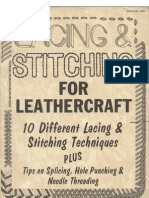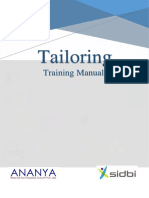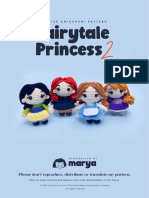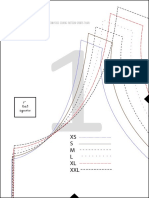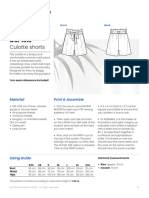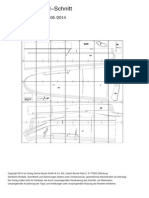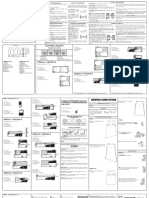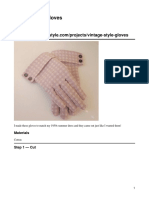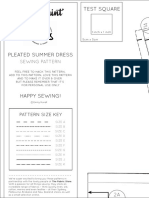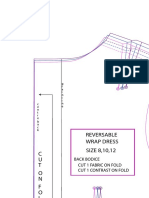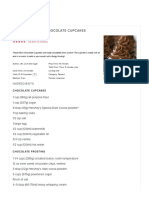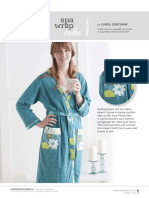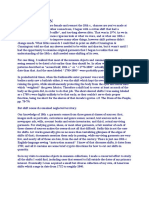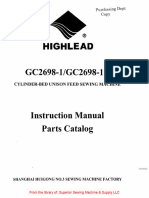VV Bias Slip Text1
VV Bias Slip Text1
Uploaded by
shafizza syed hodCopyright:
Available Formats
VV Bias Slip Text1
VV Bias Slip Text1
Uploaded by
shafizza syed hodOriginal Title
Copyright
Available Formats
Share this document
Did you find this document useful?
Is this content inappropriate?
Copyright:
Available Formats
VV Bias Slip Text1
VV Bias Slip Text1
Uploaded by
shafizza syed hodCopyright:
Available Formats
SEW VERAVENUS
“A modern make on vintage style”
VeraVenus.com
!
Cut to cling: A slim bias slip -lace trimmed or plain
Instructions
!
The pattern: It is a good idea to mirror the 1/2 front and back pattern pieces
onto new paper to make full pattern pieces. The reason for this is simple- cutting
bias is easier and more accurate as a single layer. If the slip pieces are cut
without the true bias running down the centre of the front and back it is quite
likely that your slip will not hang true and will twist around you as you wear it.
Cutting out: You’ll need roughly 2 -3 metres of fabric for a knee length slip. It
depends on the width of your fabric and which size and if you want to make it
longer. When you have made the full pattern laying it out on a table or floor
and measuring around it is the surest way to work out how much fabric you’ll
need
If your fabric is flimsy cutting out using the paper sandwich method, either 'full
sandwich' or 'open top' will help enormously. I've described how to do this in my
French Knicker tutorial so won’t repeat it here.That pdf contains lots more
sewing info on applying lace, pin hemming etc. which you may find useful in
your slip sewing as well.
I wash and iron my fabric before cutting out. It is better that fabric shrinks before
sewing than after. Even if your fabric is a synthetic washing will remove any stiffeners and generally make it softer to feel. I hear
you crying" but it's so much easier to cut out a firm or stiff (to the extent that I even read somewhere about starching silks to make
them easier to cut!!) The whole point of working fabric on the bias is the soft drapey feel of the fabric and how can you try
something on half way through making it if it is like a piece of paper? Honestly, I don't go out of my way to make things harder
than necessary for either you or myself but not sure about stiffening silk; just try the paper sandwich cutting method first.
However you do choose to go about the cutting out don't rush, take your time, be accurate. I sew almost every day... you probably
don't and understandably want this project finished as quickly as possible. But a slip that twists around your hips and seams that
hang badly isn't going make you happy. Some things just take the time they take.
So now if you’ve done the cutting out, had a cup of tea/ coffee/cocktail to recover you're ready to sew.
©veravenus March 2014
!
SEW VERAVENUS
“A modern make on vintage style”
VeraVenus.com
!
!
Take the two bust sections and add lace insets now if you want to. The trick is keeping the lace along the straight grains of the
fabric. If your lace and fabric are sturdy
enough sew the lace on with a tiny zigzag
stitch and cut the fabric away behind. If
the lace or fabric is fragile just apply it on
top with a straight stitch.There are lines
on the pattern pieces showing where I
sewed my lace on.The fragile vintage
lace on the pink fabric, a thin satin
chiffon (a devil to work with and I won't
be do that again soon!) is only applied on
top and the cream, a fairly heavy silk has
been cut away behind.
• Next finish the top edges of the bust pieces. I did mine by pin hemming and adding
lace. Lace can alternatively be laid flat on top, straight stitched in place along the
edge to hold it and then zigzagged over that. Best to do some tests on fabric scraps
before you commit to trimming the actual slip pieces. Unless you are using a very wide lace, 5cm or more i wouldn't worry about
cutting the bust pieces back to compensate for the width addition either .
And if you don't know what I meant by that then you can forget I even
mentioned it.
!
•The slip doesn't have to
have lace added at all.The
edges could simply machine
pin hemmed or finished by
hand with a plain rolled
edge or a decorative shell
hem like this one.
!
!
!
!
!
•If you intend any lace insertion on the slip body front as well, now before
attaching the bust pieces, is the time to do it. Again, keep the lace running
along the straight grain of your slip fabric.The lace bow was appliquéd as an
experiment - I wasn't sure if it would distort the bias fabric too much but it
worked pretty well. How I did the bow appliqué is in my post from August 10,
2012 if you’d like to look that up. Keeping any lace additions rather high on
the front piece is best I think as the slip wont be stretching much in the front of
your diaphragm.
!
!
©veravenus March 2014
!
SEW VERAVENUS
“A modern make on vintage style”
VeraVenus.com
!
• Run two rows of gathering stitches between the notches, pull the gathering in to match the notches on the front piece and with
right sides facing in sew together. I rarely sew this as a french seam as it can get a bit lumpy with the gathering. To finish the
seam inside you can stitch a second time a few mm away and hand overcast the
edge or even use a strip of self bias binding to finish the raw edges. (In the image
I’m using a fine nylon binding specifically for bra making but I like it for things
like this too as its very fine.) You could certainly try a french seam but I've
noticed on vintage slips and nighties that even when they do have french seaming
on other seams they often don't on under-bust gathered seams. However you do it
press the seam allowance down into the slip body.
• Next is finishing across the top of the back slip.The measurements I've given
stretch the edge a little beyond what the paper actually measures. I find this helps
to bring the waist in for a smoother fit. Personally I am always irritated when
slim cut bias garments hang away at my lower back and waist rather than fitting
in close. Finish the edge with the same method you used on the front bust edges,
lace and all.
• Sides seams now. These I do as french seams including the lace edging at the top. A long time ago one of the best pattern cutters
and machinists whom I've ever worked with and who had worked at Versace in the 60sand 70s shared her method with me for
sewing bias seams. It goes like this: On the first right sides out run tighten the tension a little, use a 2-2.5 size stitch and Just let the
fabric feed through without stretching it. Trim the seam allowance small and press it over to one side. Then wrong sides out sew
the second run but this time loosen the tension back to normal and make the stitches size 3. When the seam of the hip area is
feeding through stretch the fabric a little sideways.... below that where the skirt will hang free stretch it a little up and down.
Press the finished french seam together first and then finally to towards the back of the slip. And I've sewn my bias seams like that
for going on 30 years now. Using a new needle that is the proper size for your fabric and having the upper and lower tensions of
your machine perfectly balanced is important too. I'm amazed when hear someone say they haven't changed the needle for months
or had their sewing machine tuned in years. I change my needle with every new thing I sew and have my industrial machine
tuned twice a year.What a difference that makes!!
• Getting back on track- the hemming. As it is all bias letting the slip hang overnight on a dummy or even on a hanger is a good
idea though really I haven't found hugely critical in slip making so far (seems to make more difference in a full dress or a skirt)
Marking the hem to be level on a dummy is ideal... or a dressmaking buddy doing it for you is great. If you have to do it on your
own,it is not impossible. Wearing the slip stand straight, no twisting and look at yourself in the mirror from the front, and with
the help of a hand mirror from the sides and back. By eye gauge where it needs levelling. Take the slip off and with a strongly
contrasting colour thread hand sew large running stitches along the level line you eyed up. Try the slip on again and check the
basted line is level. Correct again if necessary and finally cut off as needed. Machine or hand roll the hem. This gets easier with
practise
• About lace on the hem: I don’t tend to sew lace on full bias hems… it just seems to cause me more aggravation than anything.
That’s not at all to say don’t do it but the only advice I can give is baste first to check it’s not pulling the hem in or stretching it
out too much.
• Straps are last. They can be straight grain or bias rouleaux ones or use bought ribbons.
!
!
!
!
!
©veravenus March 2014
!
SEW VERAVENUS
“A modern make on vintage style”
VeraVenus.com
The pattern can be made longer for a lovely bias nightgown too.
The finished tie measurements are : two front ties 53cm long x 6cm wide (21” x 2 ½”) and for the two back ties : 70cm long x 6cm
wide ( 27 ½ “x 2 ½”) Add seam allowance to those measurements.
The centre edges of the bust sections are pin hemmed and from the strap point around the back I used a self bias binding to finish
the top edge.
©veravenus March 2014
!
You might also like
- Lacing Stitching For Leather CraftDocument20 pagesLacing Stitching For Leather Craftdoris_marlene89% (47)
- Glory Allan - GA001 - Reversible Bucket Hat Sewing Pattern - 7.5in by 10Document3 pagesGlory Allan - GA001 - Reversible Bucket Hat Sewing Pattern - 7.5in by 10Bill The Beauty100% (1)
- Hijab Doll by @suada - OyuncaqDocument10 pagesHijab Doll by @suada - OyuncaqElizangela Oaquim92% (13)
- Haslam System of Dresscutting - Vintage Pattern Making For 1920S, 30S, 40S and 50S Fashions (Haslam Chart and Foundation Draftings) by BDocument8 pagesHaslam System of Dresscutting - Vintage Pattern Making For 1920S, 30S, 40S and 50S Fashions (Haslam Chart and Foundation Draftings) by Bshafizza syed hod5% (21)
- Tailoring: Training ManualDocument42 pagesTailoring: Training ManualMuhammad Tayyab Lodhi100% (5)
- Pattern Making Software PDFDocument2 pagesPattern Making Software PDFCatarina SousaNo ratings yet
- Noelle: Halter Bralette Panty Free Sewing PatternDocument15 pagesNoelle: Halter Bralette Panty Free Sewing Patternnated854834100% (5)
- Knitting Module 2023Document94 pagesKnitting Module 2023ADINAN MOHAMMEDNo ratings yet
- Ginansilyo Ni Marya Fairytale Princess 2Document34 pagesGinansilyo Ni Marya Fairytale Princess 2Libélula Ramírez100% (10)
- 1795 1810 Stays Pattern PDFDocument1 page1795 1810 Stays Pattern PDFsophiaNo ratings yet
- MDF122 - The Milla Bralette GHGFHDocument5 pagesMDF122 - The Milla Bralette GHGFHMariaMercedesAlvarezHeraNo ratings yet
- Vestido Años 30Document4 pagesVestido Años 30rebeca2a0% (1)
- How to Make Lingerie - With Information on Stitches, Embroidery and FasteningsFrom EverandHow to Make Lingerie - With Information on Stitches, Embroidery and FasteningsRating: 1 out of 5 stars1/5 (1)
- Boutique Casual for Boys & Girls: 17 Timeless Projects, Full-Size Clothing PatternsFrom EverandBoutique Casual for Boys & Girls: 17 Timeless Projects, Full-Size Clothing PatternsNo ratings yet
- Sim 2702Document4 pagesSim 2702didomessi100% (1)
- The Parker Corset: #MoodparkerpatternDocument14 pagesThe Parker Corset: #MoodparkerpatternSamNo ratings yet
- Penny Pocket A-Line Skirt: WWW - Sewnowmag.co - UkDocument19 pagesPenny Pocket A-Line Skirt: WWW - Sewnowmag.co - UkMarie CoutureNo ratings yet
- Anna Rose DressDocument36 pagesAnna Rose Dressmodtelier51No ratings yet
- Womensworkoutshirtinxs xxlfromLifeSewSavory Xr47gi PDFDocument11 pagesWomensworkoutshirtinxs xxlfromLifeSewSavory Xr47gi PDFDayana NORIEGANo ratings yet
- StitchSP13 DP PuppyRainPonchoDocument23 pagesStitchSP13 DP PuppyRainPonchoAramat ComplementosNo ratings yet
- Sylvie Dress Instruction MPDocument53 pagesSylvie Dress Instruction MPKheira BelalNo ratings yet
- 2 Hour Top Pattern Multipage PDFDocument10 pages2 Hour Top Pattern Multipage PDFpametuglavuNo ratings yet
- Molde ShortDocument18 pagesMolde Shortmonalisa.o.maiaNo ratings yet
- The Darcy Boxer Short InstructionsDocument9 pagesThe Darcy Boxer Short InstructionswertNo ratings yet
- Cape With Lapels 08:2014 #124Document36 pagesCape With Lapels 08:2014 #124Momo Rodriguez100% (1)
- Skirt WithDocument3 pagesSkirt WithRoli RoliNo ratings yet
- 1 RedHotPants PDFDocument33 pages1 RedHotPants PDFdafemsta_05No ratings yet
- GBSB Jumpsuit Free Pattern InstructionsDocument2 pagesGBSB Jumpsuit Free Pattern InstructionsKarlita50% (2)
- F S Cara Blouse Pattern CombinedDocument31 pagesF S Cara Blouse Pattern CombinedAmy WapinskiNo ratings yet
- Enterito Patron GratisDocument2 pagesEnterito Patron GratisHalison AriasNo ratings yet
- Sn02 p22 Chloe BlouseDocument16 pagesSn02 p22 Chloe BlouseAnonymous TfdIwx100% (1)
- 01/2012 Wrap Blouse: By: Burda Style MagazineDocument5 pages01/2012 Wrap Blouse: By: Burda Style MagazinedidomessiNo ratings yet
- Cutting Layouts: Dress A / Vestido ADocument3 pagesCutting Layouts: Dress A / Vestido AdidomessiNo ratings yet
- BL Us A Burda Style 6003 InstruccionesDocument3 pagesBL Us A Burda Style 6003 InstruccionesRicardo AtiamNo ratings yet
- Serena Coat Template: Print OUT & KeepDocument43 pagesSerena Coat Template: Print OUT & Keepdaisy22No ratings yet
- #5129 Dress InstructionDocument2 pages#5129 Dress Instructionmr kdrama0% (1)
- Peignoir KimonoDocument7 pagesPeignoir Kimonomicault100% (1)
- Vintage Style Gloves: By: My StarbrinkDocument5 pagesVintage Style Gloves: By: My StarbrinkmicaultNo ratings yet
- Duffle CoatsDocument94 pagesDuffle CoatsastuyaNo ratings yet
- RP Pattern Talia Tunic and Dress A4Document47 pagesRP Pattern Talia Tunic and Dress A4Witchywooamilou100% (1)
- StitchSP13 DP SweetRainJacketDocument66 pagesStitchSP13 DP SweetRainJacketSinger Porto100% (2)
- Blusa Burdastyle 6003 Instrucciones PDFDocument3 pagesBlusa Burdastyle 6003 Instrucciones PDFMilagro EspinozaNo ratings yet
- 320-16 Instruction Blouse Aida ENDocument1 page320-16 Instruction Blouse Aida ENHollyster StarNo ratings yet
- 109 Blouse 1020 InstructionDocument2 pages109 Blouse 1020 Instructionalexudza100% (1)
- OLS1803 HyacinthBraletteInstructionsDocument20 pagesOLS1803 HyacinthBraletteInstructionsmariarodNo ratings yet
- 12/2011 Long Sleeved Plus Size Dress: By: Burda Style MagazineDocument5 pages12/2011 Long Sleeved Plus Size Dress: By: Burda Style MagazinedidomessiNo ratings yet
- Ref010 XS-3XL Louellapatterns A4Document5 pagesRef010 XS-3XL Louellapatterns A4flor.alarcon.0101No ratings yet
- Whitney Bottoms PDF Edgewater AvenueDocument13 pagesWhitney Bottoms PDF Edgewater AvenueAnimus One TigerNo ratings yet
- Pleated Summer Dress Pattern A4-1-1 PDFDocument40 pagesPleated Summer Dress Pattern A4-1-1 PDFWijaya HanNo ratings yet
- Fabrics-store-Donna - Terracotta Linen Dress Pattern-1Document38 pagesFabrics-store-Donna - Terracotta Linen Dress Pattern-1Kasia M.No ratings yet
- Ebb & Flow Pants InstuctionsDocument12 pagesEbb & Flow Pants InstuctionsenilNo ratings yet
- Coccon Jacket Pattern A4 PDFDocument16 pagesCoccon Jacket Pattern A4 PDFcaro100% (3)
- Kasia Skirt InstructionsDocument4 pagesKasia Skirt InstructionsbeletraNo ratings yet
- Sportivny Top PDFDocument12 pagesSportivny Top PDFmariaartesana100% (1)
- Starburst Skirt 052012 - OriginalDocument4 pagesStarburst Skirt 052012 - Originaldidomessi100% (1)
- Frock in Beehive PATTERNDocument24 pagesFrock in Beehive PATTERNbehnamin_rahmani100% (2)
- Long Metallic Wrap Dress - OriginalDocument4 pagesLong Metallic Wrap Dress - OriginalBilgi MabediNo ratings yet
- Measure To Make Sure Pattern Printed Accurately: # Test SquarDocument19 pagesMeasure To Make Sure Pattern Printed Accurately: # Test SquarmariarodNo ratings yet
- C228 PDFDocument8 pagesC228 PDFtemplarhistri18No ratings yet
- Updated Bodice Skirt PatternDocument20 pagesUpdated Bodice Skirt PatternStephanie ThompsonNo ratings yet
- Panty Dama Rizada PDFDocument14 pagesPanty Dama Rizada PDFadriana50% (2)
- Kristines Ruffled ShortsDocument15 pagesKristines Ruffled ShortsLinh Kurt100% (1)
- RUBY SLIP InstructionsDocument9 pagesRUBY SLIP Instructionspatternscissorscloth100% (2)
- Vestido para El Verano Burdastyle 6004 Patron Gratis InstruccionesDocument3 pagesVestido para El Verano Burdastyle 6004 Patron Gratis InstruccionesRoxy ParedesNo ratings yet
- Wrap Around Dress Pattern PDFDocument8 pagesWrap Around Dress Pattern PDFStefaniaRosatiNo ratings yet
- Darcy Bralette PatternDocument9 pagesDarcy Bralette PatternZuzanaVaskova100% (1)
- Best Crab Cake Recipe - How To Make Crab CakesDocument2 pagesBest Crab Cake Recipe - How To Make Crab Cakesshafizza syed hodNo ratings yet
- Best Homemade Chocolate Cupcake Recipe - Moist & Fluffy CupcakesDocument3 pagesBest Homemade Chocolate Cupcake Recipe - Moist & Fluffy Cupcakesshafizza syed hodNo ratings yet
- How To Do Kegel Exercises: 10 Second SummaryDocument1 pageHow To Do Kegel Exercises: 10 Second Summaryshafizza syed hodNo ratings yet
- Best Red Velvet Cake - Cafe DelitesDocument2 pagesBest Red Velvet Cake - Cafe Delitesshafizza syed hodNo ratings yet
- Module 1 - Jacket InterfacingDocument31 pagesModule 1 - Jacket Interfacingshafizza syed hodNo ratings yet
- Veravenusa4biasslip PDFDocument25 pagesVeravenusa4biasslip PDFshafizza syed hodNo ratings yet
- Pdfanddoc 134644 PDFDocument76 pagesPdfanddoc 134644 PDFshafizza syed hodNo ratings yet
- Magic Monday FinalDocument4 pagesMagic Monday FinalAnnalisa GianfeliceNo ratings yet
- Magazine N°106 - Quiltmania EditionsDocument1 pageMagazine N°106 - Quiltmania Editionsmarianne fjordbakkNo ratings yet
- The Land of Green PlumsDocument253 pagesThe Land of Green PlumszhxalexNo ratings yet
- Eat Like Joey Dress Like Rachel Cook Like Monica Hoodie - Friends TV Show ApparelDocument1 pageEat Like Joey Dress Like Rachel Cook Like Monica Hoodie - Friends TV Show ApparelDanna L. RamirezNo ratings yet
- QUARTER 3 Childrens Wear FACT SHEETS (Complete)Document7 pagesQUARTER 3 Childrens Wear FACT SHEETS (Complete)Sharmaine Rose Butal IcongNo ratings yet
- CuttingDocument30 pagesCuttingsatish.121180% (5)
- Ensamplario Atlantio II 1Document41 pagesEnsamplario Atlantio II 1Rebeca Marguita Burkert da SilvaNo ratings yet
- Manual de Servico Janone MC550EDocument59 pagesManual de Servico Janone MC550EandersondelgadogomesNo ratings yet
- Nina?Document63 pagesNina?Donaldo Perez Pablo100% (1)
- Khalat XS-XLDocument48 pagesKhalat XS-XLpenelopa.blogNo ratings yet
- Little Crochet BatDocument4 pagesLittle Crochet BatTú Lệ100% (5)
- Janome Memory Craft 10001 Sewing Machine Service ManualDocument42 pagesJanome Memory Craft 10001 Sewing Machine Service ManualiliiexpugnansNo ratings yet
- Paskhalnoe VyazanieDocument14 pagesPaskhalnoe VyazanieBup Be Bac100% (2)
- Produce Simple Project in Accordance To The Specification of DesignsDocument7 pagesProduce Simple Project in Accordance To The Specification of DesignsJonesa Serrano100% (1)
- Tie and DyeDocument19 pagesTie and DyeShadior FlowsNo ratings yet
- Zipper Bucket Bag Sewing Pattern PDFDocument15 pagesZipper Bucket Bag Sewing Pattern PDFAlice WCMNo ratings yet
- DIFFERENT LEVELS OF Bartack IN TEXTILE INDUSTRY AND ITDocument8 pagesDIFFERENT LEVELS OF Bartack IN TEXTILE INDUSTRY AND ITSakshi SinghNo ratings yet
- Patron Krissa CropDocument1 pagePatron Krissa CropCaroline FavreauNo ratings yet
- Making Women's 18th Century ShiftsDocument61 pagesMaking Women's 18th Century ShiftsJoy100% (4)
- Crochet Primrose Stitch Pattern - Primrose Crochet TutorialDocument14 pagesCrochet Primrose Stitch Pattern - Primrose Crochet Tutorialcraftycow62No ratings yet
- Highlead GC2698-1, - 1BDocument40 pagesHighlead GC2698-1, - 1Bakuma ioriNo ratings yet
- WeaveTech Chapter2 HistoryDocument32 pagesWeaveTech Chapter2 HistoryAfroja IslamNo ratings yet
- Gecko (US Pattern)Document2 pagesGecko (US Pattern)ArudatoNo ratings yet
- Arts Grade 8Document35 pagesArts Grade 8Daryll glenn TumalonNo ratings yet
- PumpkinkeychainDocument3 pagesPumpkinkeychainashley tohillNo ratings yet
